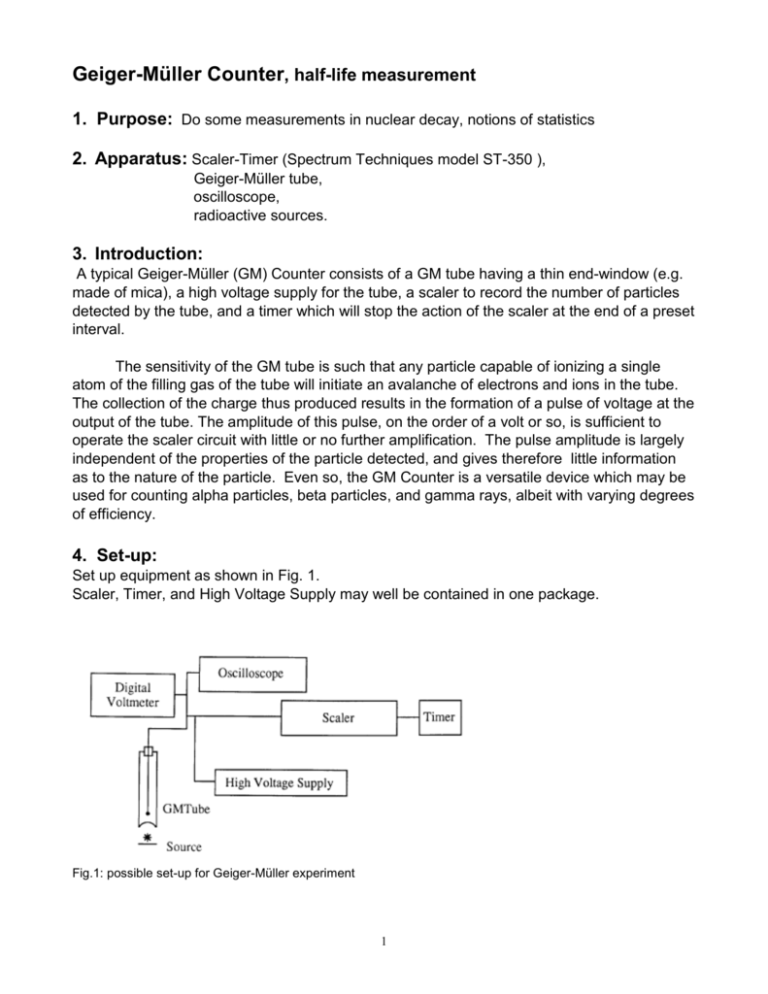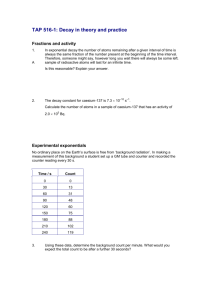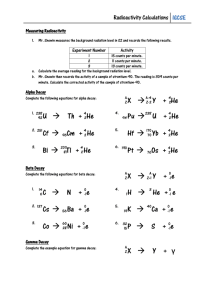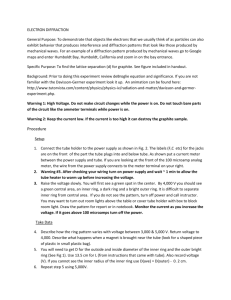GM - FSU High Energy Physics
advertisement

Geiger-Müller Counter, half-life measurement 1. Purpose: Do some measurements in nuclear decay, notions of statistics 2. Apparatus: Scaler-Timer (Spectrum Techniques model ST-350 ), Geiger-Müller tube, oscilloscope, radioactive sources. 3. Introduction: A typical Geiger-Müller (GM) Counter consists of a GM tube having a thin end-window (e.g. made of mica), a high voltage supply for the tube, a scaler to record the number of particles detected by the tube, and a timer which will stop the action of the scaler at the end of a preset interval. The sensitivity of the GM tube is such that any particle capable of ionizing a single atom of the filling gas of the tube will initiate an avalanche of electrons and ions in the tube. The collection of the charge thus produced results in the formation of a pulse of voltage at the output of the tube. The amplitude of this pulse, on the order of a volt or so, is sufficient to operate the scaler circuit with little or no further amplification. The pulse amplitude is largely independent of the properties of the particle detected, and gives therefore little information as to the nature of the particle. Even so, the GM Counter is a versatile device which may be used for counting alpha particles, beta particles, and gamma rays, albeit with varying degrees of efficiency. 4. Set-up: Set up equipment as shown in Fig. 1. Scaler, Timer, and High Voltage Supply may well be contained in one package. Fig.1: possible set-up for Geiger-Müller experiment 1 5. Measurements to be performed: 5.1 Characteristics of the GM counter: Put a radioactive source below the GM tube. Put the counter in counting mode and raise the voltage until counts are observed. Note the shape of the pulse and what happens as the voltage on the GM tube is increased. What is the minimum voltage pulse necessary to activate the counter? Measure the pulse height with the oscilloscope. Sketch a picture of the pulse shape. How would you describe it? Every GM tube has a characteristic response of counting rate versus voltage applied to the tube. A curve representing the variation of counting rate with voltage is called a plateau curve because of its appearance. The plateau curve of every tube that is to be used for the first time should be drawn in order to determine the optimum operating voltage. Find the plateau curve for your tube using the procedure outlined below. (a) Check to see that the high voltage as indicated by the meter on the instrument is at its minimum value. (b) Insert a radioactive source into one of the shelves of the counting chamber. Turn on the count switch and slowly increase the high voltage until counts just begin to be recorded by the scaler. The voltage at which counts just begin is called the "starting voltage" of the tube. Using the oscilloscope, measure the minimum signal size necessary to trigger the scaler. (c) Set counting time to 30 sec. Beginning at the starting voltage, take counts every 40 volts. Choose shelf such that you have at least 1000 counts when the high voltage is about 50V above the starting voltage. Reset scaler to zero before each count. Tabulate counts versus voltage. Continue taking counts until a voltage is reached where a rapid increase in counts is observed (or when the maximum allowed HV value is reached). Do not continue raising the voltage beyond that point – reduce voltage to about 200V above starting voltage. (d) Plot the data of (c). Identify the “plateau” (i.e. the flattest part of the curve between the knee and before the onset of the fast rise). The slope S of the plateau of a GM tube serves as a figure of merit for the tube. The slope is defined to be the percent change in count rate per 100 volts change in applied voltage in the plateau region. A slope of greater than 10% indicates that the tube should no longer be used for accurate work. The slope may be computed using 2( N 2 N1 ) 104 (1) ( N1 N 2 )(V2 V1 ) where V2 is the voltage at the high end of plateau, N2 is the number of counts at this voltage, V1 is the voltage at the low end of the plateau (just above the “knee”), and N1 the corresponding number of counts. Do you understand this equation and can you explain it? In order to compare, obtain a similar plateau curve for an old tube (if available). S (% per100V ) 2 The optimum operating voltage will be about the middle of the plateau, usually some 150 to 200 volts above the knee of the curve. Set the high voltage to this point and record the value. All the subsequent measurements are to be done with the HV set to this optimum operating voltage. 5.2 Dead-time of the GM counter There is an interval of time following the production of a pulse in the GM tube during which no other pulse can be recorded. This interval is called the dead-time of the system. If this time is known it can be used to make a correction to the observed count rate to yield the true count rate. The procedure below can give a good estimate of the dead-time. (a) Obtain a dead-time source (a “split source”) from the instructor. This source is split into two parts. Remove one half of the source and set it aside. (b) Place the carrier containing one part on the second shelf of the counting chamber and make a trial count of 1 minute duration. Get the maximum count rate you can. This should be more than 20,000 counts per minute, but if not use what you can get. (c) View the pulses on the oscilloscope and record the shortest time interval that you can see between successive pulses; this gives you an order-of-magnitude estimate of the dead time (d) Count for 200 seconds and record the counts, N1. (e) Put the two parts of the source back together, taking care not to disturb the position of the first part. Do a 200-second count of the combined parts and record as Nc. (f) Remove the part initially counted and make a 200-second count on the second part -- record counts as N2. (g) Estimate the dead-time of the GM counter using the relation: N1 N 2 N C 2 N1 N 2 (2) Convert the time thus found to microseconds (note that T is the duration of your counting -- careful – use the correct time) and record. To understand the origin of the equation, see refs [1 - 3]. (h) calculate the dead-time uncertainty, using Poisson uncertainty for the numbers of counts (i) The dead-time τ may be used to correct an observed count rate using the r R expression: (3) where 1 r r = Observed count rate R = True count rate Apply this dead time correction to N1, N2, Nc and verify that the corrected numbers N(c) (approximately) satisfy the equation N1 (c) + N2 (c) = Nc (c). (j) Calculate the rate at which the error due to dead time effects (i.e. the difference between raw and true counting rate) is 1%. 3 5.3 Statistical treatment of counting data The emission of particles by radioactive nuclei is a random process. If the time over which the decays are observed is small compared to the (mean or half-) lifetime of the radioactive nucleus, the probability for a decay to occur during a given time interval is constant (the same for every time interval of the same length). When, under identical conditions, a series of N measurements is made of the number of particles detected per unit time it will be observed that the individual measurements will vary about some average or mean value. The true mean, m, can be determined only by averaging an infinite number of measurements. However, for a finite number of observations (a finite “sample”) the best approximation of the true mean is simply the “sample mean”, i.e. the arithmetic average n mn 1 N 1 nk (n1 n2 ....nN ) (4) N k 1 N The magnitude of the deviations of individual measurements from the true mean is usually expressed in terms of a “standard deviation” (). The standard deviation is defined to be the square root of the average value of the squares of the individual deviations (rms = “rootmean-square”). The number of counts of radioactive decays for a fixed time is a random variable whose probability distribution is a Poisson distribution; the Standard Deviation for such a distribution is simply the square root of the true mean: m (5) Given a finite set of N measurements, the best approximation (the “unbiased estimator”) of the standard deviation is given by the square root of the “sample variance”, N n (n k 1 k n )2 N 1 (6) For values of m > 20 the Poisson distribution is very well approximated by the Gaussian (or “normal”) distribution for which certain confidence levels have been established in terms of the standard deviation. These confidence levels are as follows: About 68% of the number of observations made will fall within the limits of n n . About 95% of the number of observations made will fall within the limits of n 2 n About 99% of the number of observations made will fall within the limits of n 3 n This means that if one additional measurement is made, it should have a 68% chance of falling within n n . 4 When circumstances permit the making of only a single observation, the number of counts obtained, n, is used as an estimator of the true mean m and n as an estimator for its uncertainty (standard deviation n). The Standard Deviation of a gross counting rate, Rg is: Rg t Rg n Rg (7), where t is the duration of the counting. t t t To test the statistical nature of nuclear decay, do the following experiment: (a) Adjust the height of a source in the counting chamber to produce about 2000 counts per minute. (b) Take a set of 10 counts of 30 seconds duration (“set A”). (c) Compute the arithmetic mean n . (d) Compute the standard deviation s for a Poisson distribution of mean n . (e) Compute the individual deviations from the mean (nk n ) and record in a table. Do they sum very nearly to zero? Explain why they do. (f) Square the (nk n ) , sum the square and apply Equation (6) to obtain the standard deviation n. Compare n with s (g) Count the number of measurements whose values lie within n n . Now take a second set of ten measurements (“set B”) and repeat the same analysis. Compare the two mean values and sigmas. How many measurements of set (B) fall within the one-sigma interval of set (A)? 5.4 Background Measurements Extraneous radiation called background radiation is always present. Gamma rays emitted by certain radioisotopes in the ground, the air, and various building materials as well as cosmic radiation can all provide counts in a detector in addition to those from a sample being measured. This background counting rate should always be subtracted from a sample counting rate if you need to obtain the rate from the sample alone. Obtain a background counting rate using a 5-minute sample time. 5.5 Decay constant of an unknown radioisotope The activity (number of disintegrations per unit time) of a radioisotope is expressed as A(t2 ) A(t1 )exp( (t2 t1 )) (10) where A(t) = activity at time t = decay constant, characteristic of the radioisotope = probability per unit time for a radioactive decay to occur (the mean-life = 1/) 5 The half-life, T½ of a radioisotope is defined to be that interval during which the activity decreases to one-half its value at the beginning of the internal. The half-life is given by T1 2 ln 2 ln 2 (11) The counting rate of a sample of a radioisotope may be considered to be directly proportional to the activity at the moment of measurement provided that the counting interval is short compared to the half-life. Reasonably short half-lives can be determined by measuring activity at regular intervals. The logarithm of the activity when plotted as a function of elapsed time should yield points falling on a straight line. Explain why. Obtain your unknown sample from the instructor, measure the activity as a function of time and find the decay constant. You should take at least 20 measurements of the activity, for half-minute intervals, making sure that the time between counting periods is minimized (why is that important?) For the decay constant determination, you should correct the counts for dead-time and background (explain why you should do this). 6. Analysis, error estimation: Dead-time: Estimate the uncertainty on your dead-time measurement from the uncertainties on the number of counts (use Poisson uncertainties for these); are there any other sources of error that could influence this measurement? Decay constant measurement: Having N measurements of activity gives you N-1 independent measurements of the decay constant. Estimate the uncertainty on each individual decay constant measurement from the uncertainties on the number of counts (remember that they are Poisson-distributed!). Determine the average of the N-1 values for the decay constant, and calculate the standard deviation. In addition, determine also a weighted mean of these values, with weight = (1/σ i2). Taking a weighted average like this is the appropriate method if the uncertainties of the individual measurements are very different from each other. Furthermore, you should also determine the decay constant from the slope of the straight line fitted to a graph of the logarithm of the activity versus elapsed time. The uncertainty on this slope gives you another estimate of the uncertainty on the decay constant. (See the statistics hand-out or the statistical methods chapter of the textbook on how to determine the uncertainty on the slope). From the decay constant, derive the mean life and the half-life (with their uncertainties). Compare the values and uncertainties obtained by the different methods, and discuss their relative merits. 7. Report: You should treat every step in this experiment as a different measurement, with its data, analysis and conclusion together in one section. Your report should have a clear and complete discussion of the principles underlying the 6 functioning of a GM Counter, as well as its characteristics as determined from your experimental data. In addition, you should have a complete description of the data analysis, including determination of uncertainties. You need to have a calculation of the uncertainty on dead-time, decay constant and half-life (for all methods of determining the decay constant and half-life). You must also answer the following questions: (1) what are physical phenomena that are initiated by the passage of an ionizing particle in the GM tube? (2) What makes it possible for the GM tube to also count X-rays and -rays (photons)? (3) what is the size (in V) of the smallest signal from the GM tube that is big enough to trigger the counter circuit? (4) what is the smallest time between two successive GM tube output signals that you can see on the oscilloscope? (5) Given the dead-time determined by you, what is the counting rate at which the error due to the finite dead-time is 1% of the rate? (6) When taking the counts for the decay constant measurement, why is it important that the time between two successive measurement periods be minimized? If you had appreciable delays between successive counting periods (without correcting for this), would that cause you to over- or underestimate the half-life? (Explain) 8. References: [1] Glenn F. Knoll: Radiation Detection and measurement, John Wiley & Sons, New York 1989 (2nd ed.), 1999 (3rd ed.) [2] William Leo: Techniques for Nuclear and Particle Physics Experiments : A How-To Approach; Springer Verlag, New York 1994 (2nd ed.) [3] A. Melissinos: Experiments in Modern Physics, Academic Press, New York 1966 [4] Ortec Application note 34: Experiments in Nuclear Science http://www.ortec-online.com/Library/an34.aspx [5] Spectrum Techniques Manual – posted at http://www.physics.fsu.edu/Users/Wahl/labmanuals/SpectrumTechniques/Manuals/Studentmanual.pdf 7







